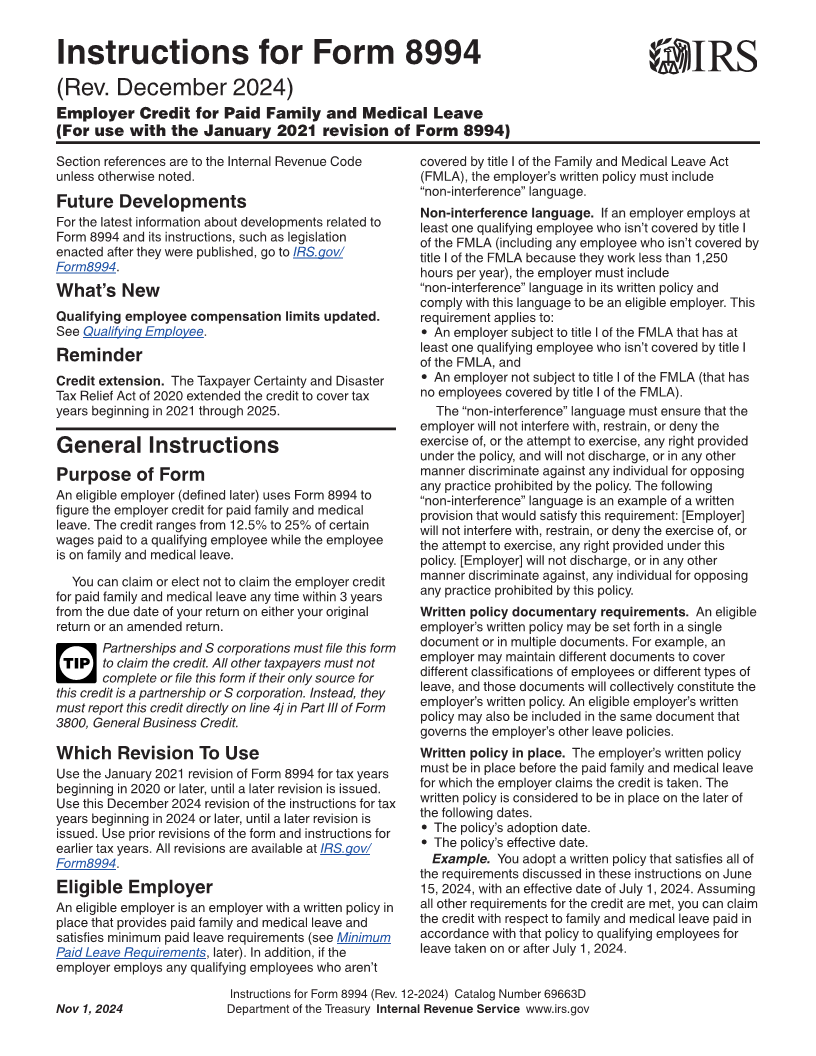
Enlarge image
Userid: CPM Schema: Leadpct: 100% Pt. size: 10 Draft Ok to Print
instrx
AH XSL/XML Fileid: … orm-8994/202412/a/xml/cycle05/source (Init. & Date) _______
Page 1 of 10 10:05 - 16-Dec-2024
The type and rule above prints on all proofs including departmental reproduction proofs. MUST be removed before printing.
Instructions for Form 8994
(Rev. December 2024)
Employer Credit for Paid Family and Medical Leave
(For use with the January 2021 revision of Form 8994)
Section references are to the Internal Revenue Code covered by title I of the Family and Medical Leave Act
unless otherwise noted. (FMLA), the employer’s written policy must include
“non-interference” language.
Future Developments
Non-interference language. If an employer employs at
For the latest information about developments related to least one qualifying employee who isn’t covered by title I
Form 8994 and its instructions, such as legislation of the FMLA (including any employee who isn’t covered by
enacted after they were published, go to IRS.gov/ title I of the FMLA because they work less than 1,250
Form8994. hours per year), the employer must include
What’s New “non-interference” language in its written policy and
comply with this language to be an eligible employer. This
Qualifying employee compensation limits updated. requirement applies to:
See Qualifying Employee. • An employer subject to title I of the FMLA that has at
least one qualifying employee who isn’t covered by title I
Reminder of the FMLA, and
Credit extension. The Taxpayer Certainty and Disaster • An employer not subject to title I of the FMLA (that has
Tax Relief Act of 2020 extended the credit to cover tax no employees covered by title I of the FMLA).
years beginning in 2021 through 2025. The “non-interference” language must ensure that the
employer will not interfere with, restrain, or deny the
exercise of, or the attempt to exercise, any right provided
General Instructions under the policy, and will not discharge, or in any other
manner discriminate against any individual for opposing
Purpose of Form
any practice prohibited by the policy. The following
An eligible employer (defined later) uses Form 8994 to “non-interference” language is an example of a written
figure the employer credit for paid family and medical provision that would satisfy this requirement: [Employer]
leave. The credit ranges from 12.5% to 25% of certain will not interfere with, restrain, or deny the exercise of, or
wages paid to a qualifying employee while the employee the attempt to exercise, any right provided under this
is on family and medical leave. policy. [Employer] will not discharge, or in any other
You can claim or elect not to claim the employer credit manner discriminate against, any individual for opposing
for paid family and medical leave any time within 3 years any practice prohibited by this policy.
from the due date of your return on either your original Written policy documentary requirements. An eligible
return or an amended return. employer’s written policy may be set forth in a single
Partnerships and S corporations must file this form document or in multiple documents. For example, an
TIP to claim the credit. All other taxpayers must not employer may maintain different documents to cover
complete or file this form if their only source for different classifications of employees or different types of
this credit is a partnership or S corporation. Instead, they leave, and those documents will collectively constitute the
must report this credit directly on line 4j in Part III of Form employer’s written policy. An eligible employer’s written
3800, General Business Credit. policy may also be included in the same document that
governs the employer’s other leave policies.
Which Revision To Use Written policy in place. The employer’s written policy
Use the January 2021 revision of Form 8994 for tax years must be in place before the paid family and medical leave
beginning in 2020 or later, until a later revision is issued. for which the employer claims the credit is taken. The
Use this December 2024 revision of the instructions for tax written policy is considered to be in place on the later of
years beginning in 2024 or later, until a later revision is the following dates.
issued. Use prior revisions of the form and instructions for • The policy’s adoption date.
earlier tax years. All revisions are available at IRS.gov/ • The policy’s effective date.
Form8994. Example. You adopt a written policy that satisfies all of
the requirements discussed in these instructions on June
Eligible Employer 15, 2024, with an effective date of July 1, 2024. Assuming
An eligible employer is an employer with a written policy in all other requirements for the credit are met, you can claim
place that provides paid family and medical leave and the credit with respect to family and medical leave paid in
satisfies minimum paid leave requirements (see Minimum accordance with that policy to qualifying employees for
Paid Leave Requirements, later). In addition, if the leave taken on or after July 1, 2024.
employer employs any qualifying employees who aren’t
Instructions for Form 8994 (Rev. 12-2024) Catalog Number 69663D
Nov 1, 2024 Department of the Treasury Internal Revenue Service www.irs.gov








